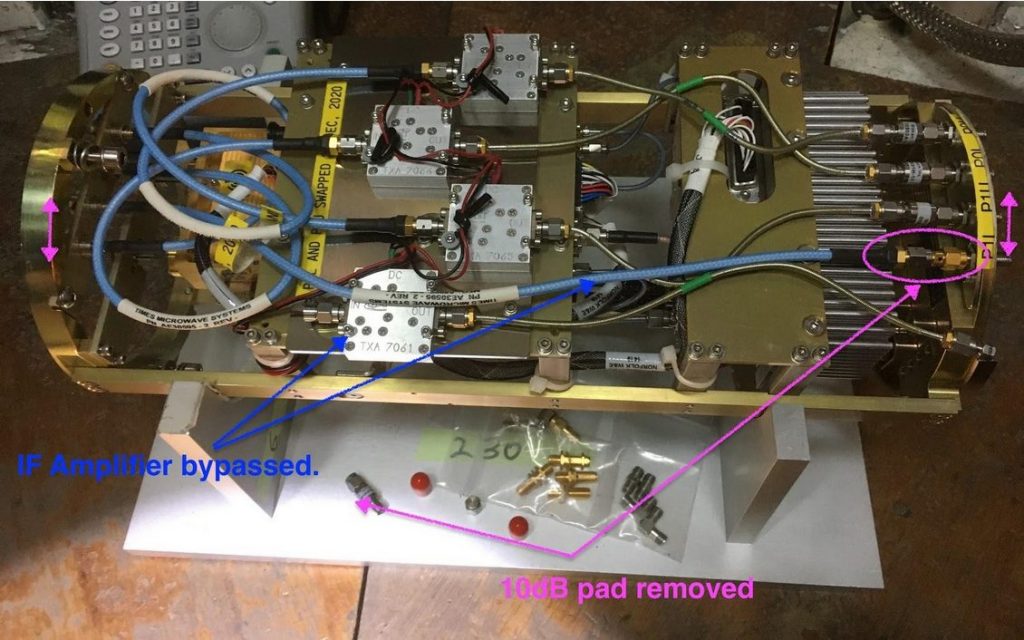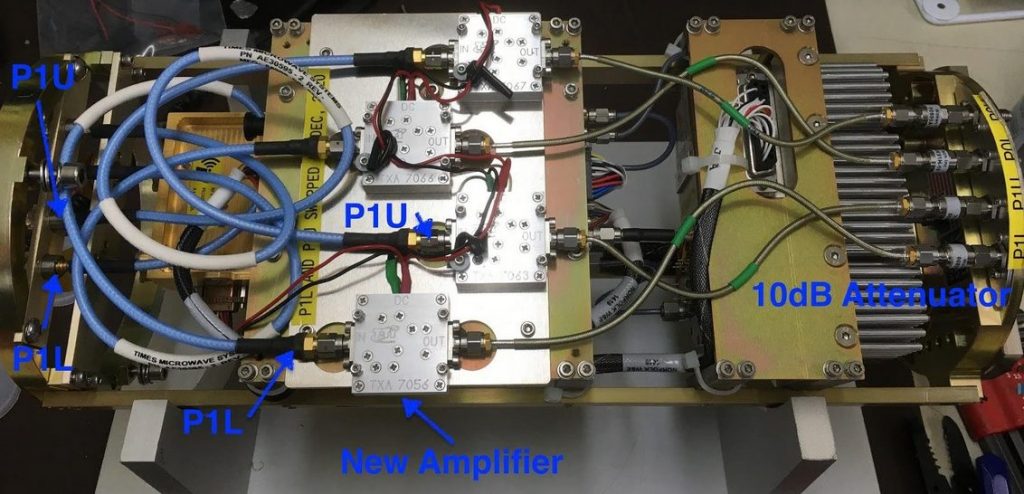|
  Figure 4: Photo of the ʻŪʻū Warm Cartridge Assembly. Top: instrument configuration with the IF Low Noise Amplifier bypassed on NU1L. Bottom: instrument configuration after the replacement of the IF Low Noise Amplifier. Figure 4: Photo of the ʻŪʻū Warm Cartridge Assembly. Top: instrument configuration with the IF Low Noise Amplifier bypassed on NU1L. Bottom: instrument configuration after the replacement of the IF Low Noise Amplifier.
Observatory Update - Dr. Harriet Parsons, Head of Operations, EAO
They say you are only as old as you feel, but a telescope really is only as old as its latest instrument! Right now JCMT staff are commissioning Nāmakanui, the JCMT’s latest instrument that was installed at the telescope in September 2019. Nāmakanui was built by a team at ASIAA (Taiwan) and is on loan to the JCMT as a spare receiver for the Greenland Telescope. Nāmakanui will enable our community to observe the complex chemistry of the Universe at wavelengths around 3.5mm, 1.3mm, and 0.9mm (86GHz, 230GHz, and 345GHz) using the instrument’s three inserts: ʻAlaʻihi, ʻŪʻū, and ʻĀweoweo. For the past year, staff focus has been on the 230GHz insert ʻŪʻū.
Commissioning of ʻŪʻū is nearing completion. The instrument is finally in a stable hardware state after mixer replacements, cable work and then in early March the replacement of a Low Noise Amplifier (LNA) in the Warm Cartridge Assembly, see Figure 4. In addition to the hardware, several software bugs discovered during the commissioning processes have been resolved and the overall efficiency in terms of data storage has been improved for both ʻŪʻū/Nāmakanui data (blank data now not recorded) as well as for HARP data. Staff are also working on code for the calculation of the ʻŪʻū Main Beam Efficiency that will be critical for users.
The final focus now for the ʻŪʻū system is on the backend, ACSIS. For a number of months, artificial p-cygni-like features were causing issues in the baseline of some data. This issue has been resolved by staff meticulously testing and, where necessary, replacing cables and connections within ACSIS. Additionally, an issue with some low-level spurious lines has been determined to be related to how far Nāmakanui is pushing the limits of ACSIS - specifically a filter on one of the LO stages (LO2). In order to adapt to how much ʻŪʻū and ʻĀweoweo are pushing ACSIS due to their larger IF ranges a new filter has been ordered and once installed it is expected that the spurious line issue will be resolved.
With the effort to commission ʻŪʻū coming to a close, observatory staff will shift focus to the 345GHz insert ʻĀweoweo. Already observatory staff have finalized the pointing model for this insert and are taking the first step in the commissioning process of observing standard sources as a way to check system performance. It is likely that the observatory will offer Shared Risk Observing with ʻĀweoweo during the 22A call for proposals.
ʻĀweoweo will be a fantastic tool for the EAO community - particularly for those interested in understanding the chemistry of compact sources. To a sensitivity of 0.01K in CO (3-2) ʻĀweoweo will be a factor of ~2.5 times faster than HARP towards a single point source. ʻĀweoweo will also when fully commissioned, have a wider frequency coverage than HARP (276 – 371GHz, compared to 325 - 375 GHz). HARP, with its 16 receptors, will remain more effective for covering large fields of view but we encourage our community to see how ʻĀweoweo can be used to maximize their science. Although the aim is to open the first ʻĀweoweo call for 22A this new Nāmakanui 345GHz insert might be available earlier, so be sure to keep an eye out for its advertisement during inter-semester calls as it may be available to users through the Rapid Turnaround and/or Urgent queue Call.
Both ʻŪʻū and ʻĀweoweo are expected to be used during the upcoming 2021 Event Horizon Telescope (EHT) campaign. Staff are excited to use these instruments during this ambitious global endeavor to understand the Black Holes at the center of M87 and at the center of our Milky Way Galaxy. Notable work from staff in preparation for this campaign has included the installation of a UPS unit in the Plinth area to support the EHT’s MARK6 recorders and the addition of new remote monitoring systems to remove the pressure for staff to be at the summit during EHT observing. Science support and monitoring of systems will be done remotely this year both from the EAO offices in Hilo and from our staff’s remote workspaces at home. The campaign is expected to take place in mid-April. |